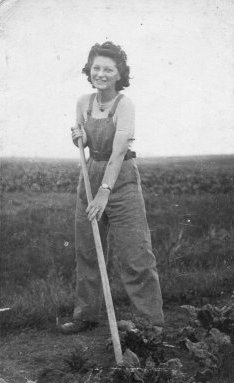Lilies on the Land
The Women's Land Army

Marguerite Bettles
Prior to the Second World War, agriculture in Britain was in a state of decline. Food imports were up to 70% and in 1939 the possibility of a German sea-blockade provoked the fear of national starvation. Women were needed to bring in the harvest and to put 2 million acres under the plough at a time when thousands of men were once more leaving the land to join the forces. From the organisation established in World War I, the Women's Land Army was reformed.
Lady Gertrude Denman was the pioneer of the movement and despite official prevarication the Women's Land Army came into being. Women's committees based on the Women's Institute were set up in every county to manage and recruit for the WLA. Hundreds of young women were attracted to the organisation, many of whom had never been into the British countryside. These women were to take on every necessary activity required for the production of food.
Initially the National Farmers' Union presented bitter opposition to the Land Army, and in some areas of the farming community Land Girls had to overcome deep suspicion. Dedication and hard work challenged discrimination but many suffered poor treatment and harsh conditions. Few however were to regret their choice.
In 1941 an urgent shortage of telegraph and timber poles brought about the recruitment of a number of girls to work in the forests as pole selectors. They were known as 'Lumber Jills', or 'Pole Cats'. In 1942 the first Women's Timber Corps training camp was set up in Suffolk.

Kathleen Harris
By July 1943 there were 87,000 Land Girls and they were joining at the rate of 4,000 a month. Despite this, in 1944 the government, led by Ernest Bevin, declared that Land Girls would be excluded from post-war education and training schemes. This led to protests and strikes, and Lady Denman resigned. However, Her Majesty the Queen made the people aware of her support for the WLA and eventually the government was forced to compromise. A Land Army Benevolent Fund was promised £150,000 and resettlement grants of £150 were agreed, but Land Girls received no medals for their services. The much prized uniform was taken back. One was only allowed to keep greatcoats and shoes, but only if the greatcoat was dyed blue·
The Women's Land Army and Women's Timber Corps continued to serve until 1950. It may not come as a surprise to hear that the first cry of protest at their disbandment came from the National Farmers' Union.
In 2000 the Women's Land Army were invited for the first time by the British Government to offer their respects at the cenotaph. They will be there again this year.
For many women, the experience of being in the Women's Land Army was profound and there is a great deal of remarkable documentation of their service. The Lions part are privileged to have been the recipients of some of these accounts in person, and to receive unique hand written accounts amongst the130 letters sent to us. The remarkable vivacity, courage and endurance frequently expressed in these recollections, the humour, affection and outrage: rich descriptive prose, intricate detail and personal insight: all these elements have come together in what we have read in the letters. They have filled us with admiration, love and respect. We wish to say thank you: you are our heroes.

